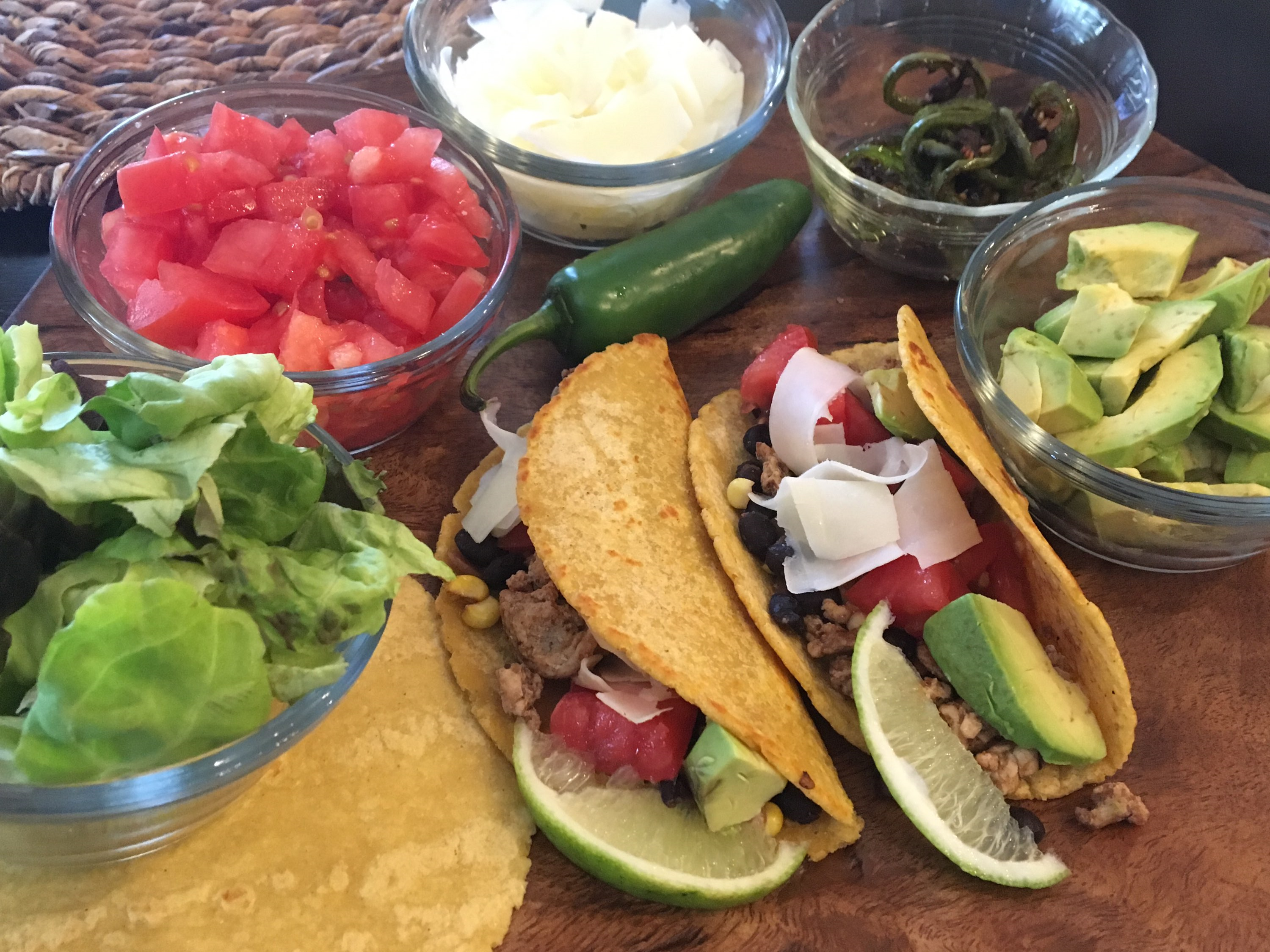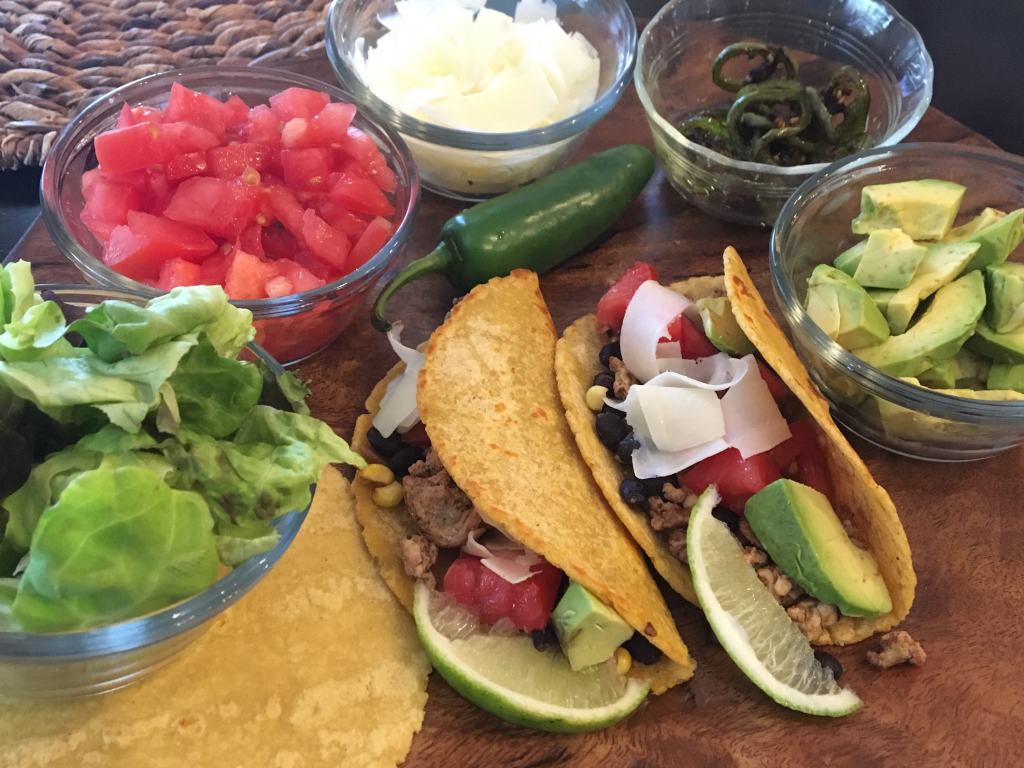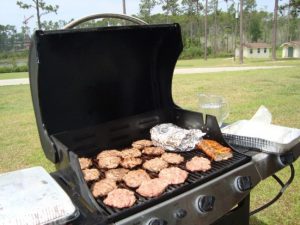
by Pam Allen | Jun 23, 2018
Tacos are a traditional Mexican dish with a mixture of various fillings on a flat bread tortilla. Having recently visited the Yucatan Peninsula and consumed tacos on a daily basis, it became evident that even in Mexico, different regions make their tacos with local available produce, meats, beans and rice. The American version can consist of anything from local produce like zucchini, squash and corn as well as the traditional tomatoes, cheese and lettuce.
Try this taco recipe for a slant on local flavor and taste. My goal is to build a taco that is tasty, local and provides creativity in the ingredients. We will use some of the traditional elements but stick with me as we explore various toppings to make your taco healthy and fresh.
Select your Tortilla

Building a Healthy Taco Using Local Produce. Photo Credit: Pamela Allen
Tortillas are varied in size, color and grain. For a healthy option select the smaller size that are made from whole grains. My favorite is a corn blended tortilla in the six inch circle.
Start with a Protein
The filling can be made from ground turkey, chicken, pork, fish or hamburger. For a vegetarian option try tofu crumbles, black beans or refried vegetarian beans. Brown the meat using your favorite Mexican spice like chili powder, garlic, cumin, white pepper and onion powder.
Pick your Filling
Local vegetables this time of year that will add flavor and color can be used as a filling. Try spiral cut squash using yellow squash or zucchini. Cook in a small amount of olive oil to tenderize. You will want to keep them crunchy so don’t overcook them. Also, shave off fresh corn and add it to your filling or mix it in with your protein.
Pick your toppings
Diced tomatoes make a great topping and add color and flavor. A squeeze of fresh lime juice is also a favorite. Other toppings could include diced avocado or sliced hot peppers like jalapeno, bell or other peppers that grow well in our area. Traditional toppings include various types of shredded cheese and sour cream.
Don’t forget the Fresh Herbs
Cilantro grows very well in this area as well as chives, onions and parsley. Fresh herbs add a splash of color and flavor.
Finishing touches
Try the homemade salsa recipe for a side dish with chips or for a topping to pep up the flavor or your healthy taco.
Fresh Salsa
2-3 medium sized fresh tomatoes (diced into small pieces)
1/2 red onion diced
Peppers of your choice – jalapeno (hot) or bell pepper (milder)
Juice of one lime
1/4 cup chopped cilantro
Salt and pepper to taste
May add some spices like chili powder or cumin for flavor.
Prepare all the ingredients and mix in a bowl. Store in refrigerator for up to 2 days.

by Dorothy C. Lee | Apr 24, 2018
Grill Out Safely This Summer
Perhaps it’s the gentle climate with temperatures conducive to outdoor cooking for much of the year. Or it might be that an outdoor get-together with family, friends, and good food is a great way to celebrate the summer. Whatever the reasons, outdoor cookery is firmly established as a tradition in the South.
Outdoor cookery has given rise to many unique and flavor-filled recipes for foods that can be prepared on even the simplest grill. If long days of summer have you longing to fire up the grill, the following tips, delicious recipes, and helpful grilling charts will help make your outdoor cooking experience easy, safe, and rewarding.

Grilling
Photo Credit: Dorothy Lee
Safety is an important consideration when operating a grill. Improper use can cause a fire or explosion. Keep the area around a lighted grill clear of combustible materials, and never use a grill in an enclosed area such as a sheltered patio or a garage. Avoid wearing loose-fitting clothing that may catch fire. The cooking grids should be cleaned after every cookout. The last thing you want to do is cause someone to become ill due to improper cleaning or unsafe food preparation practices.
Wash your hands with hot soapy water for at least 20 seconds before starting to prepare any foods and wash your hands again if you do anything else—change a diaper, pet an animal, or blow your nose, for example. Cover any cuts or sores on your hands with a bandage or use plastic gloves. If you sneeze or cough while preparing foods, cover your mouth and nose with a tissue and turn your face away, or cough into your sleeve. Always wash your hands afterwards.
Bacteria multiply rapidly at room temperature. Most food-borne illness-causing bacteria cannot grow well at temperatures below 40°F or above 140°F. Thaw foods in the refrigerator or in the microwave. Never leave foods out at room temperature.
Keep everything that touches food clean. Bacteria can hitch rides around your kitchen on all sorts of things—plates and cutting boards, dirty utensils, dish rags and sponges, unwashed hands.
Never chop fresh vegetables or salad ingredients on a cutting board that was used for raw meat without properly cleaning it first. If possible, keep a separate cutting board just for the preparation of raw meat, poultry, and fish.
Wash cutting boards thoroughly with hot soapy water, and then sanitize with a solution of household bleach and water.
The most popular meat for outdoor grilling is beef, particularly ground beef. If ground beef burgers are to be the feature of your next cookout select freshly ground meat that has fat content of about 15%. Form the meat into loose patties. Cook hamburger patties to an internal temperature of 160°F.
Keep raw meat, poultry, fish, and their juices from coming into contact with other foods during preparation, especially foods that will not be cooked. Wash all utensils and your hands with hot soapy water after contact with raw meat.
Marinate meat, poultry and seafood in the refrigerator in a covered, non-metal container. Throw away any leftover marinade.
Grill food to a safe internal temperature. Use a meat thermometer to assure correct doneness of the food being grilled.
Safe minimum internal temperatures:
- Poultry (whole, ground, and breasts): 165°F
- Hamburgers, beef: 160°F
- Beef, veal, and lamb (steaks, roasts & chops):
- Medium rare: 145°F
- Medium: 160°F.
Hold meat at 140°F until served. Use a clean platter for transferring cooked meat from grill to serving table.
Summer is the time for getting together with friends and family and cooking outdoors. Make your outdoor grilling experience safe and enjoyable.
Safe Food Handling Fact Sheet, USDA, Food Safety and Inspection Series, https://www.foodsafety.gov/
When we think of foods to prepare outdoors we almost immediately think meat. However, grilled vegetables and grilled fruits make a delicious accompaniment to grilled meats.
Corn on the Cob Kabob
- 2 medium red onions, cut into 8 wedges each
- 4 fresh ears sweet corn, husked, silks removed, and cut crosswise into 4 pieces each
- Nonstick cooking spray
- ¼ cup butter, melted
- ¼ teaspoon garlic powder
- ¼ teaspoon onion powder
- ¼ teaspoon dried oregano, crushed
On each of eight 12-inch wooden skewers, alternately thread 2 onion wedges and 2 pieces of corn, leaving about ¼ inch between each vegetable. Lightly coat vegetables with nonstick spray.
For a charcoal grill, grill kabobs on the rack of an uncovered grill directly over medium coals for 15 to 18 minutes or until vegetables are tender and brown, turning occasionally to brown evenly. (For a gas grill, preheat grill. Reduce heat to medium. Place kabobs on grill rack over heat. Cover, grill as above.)
In a small bowl, combine butter, garlic powder, onion powder and oregano. Brush over vegetables. Makes 4 servings.
Cinnamon-Grilled Peaches
- 4 large ripe freestone peaches
- Eight 3-inch cinnamon sticks
- 8 fresh mint leaves
- 4 tablespoons unsalted butter
- ¼ cup firmly packed brown sugar
- ¼ cup dark rum
- ½ teaspoon ground cinnamon
- Pinch salt
- Peach or vanilla ice cream, for serving
Rinse the peaches and blot them dry with paper towels. Cut each peach in half and discard the pit. Then, cut each peach into quarters. Using a pointed chopstick or metal skewer, make a starter hole in the center of each peach quarter, working from the pit side to the skin side. Skewer 2 peach quarters on each cinnamon stick, placing a mint left between the 2 quarters.
Combine the butter, brown sugar, rum, cinnamon, and salt in a saucepan and bring to a boil over high heat. Let the glaze boil until thick and syrupy, about 5 minutes.
Prepare and preheat the grill to high. Brush and oil the grate. Next, place the skewered peaches on the hot grate and grill until nicely browned, 3 to 4 minutes per side, basting with the rum and butter glaze. Spoon any remaining glaze over the grilled peaches and serve at once. Peach or vanilla ice cream make a great accompaniment.




